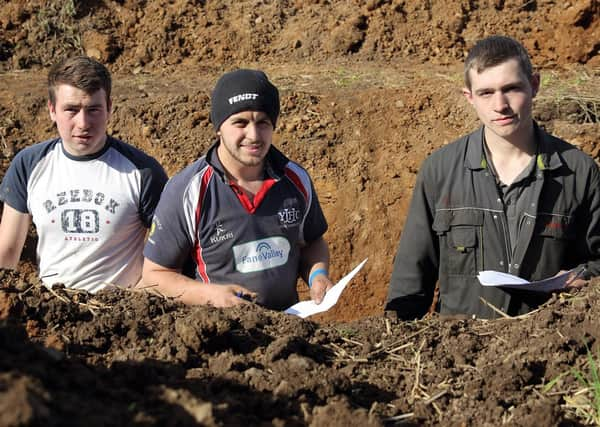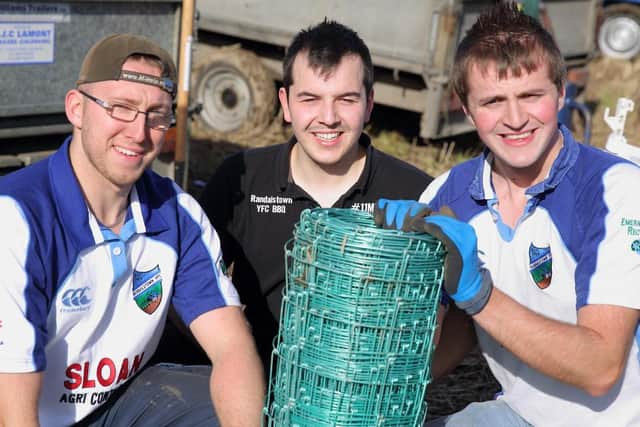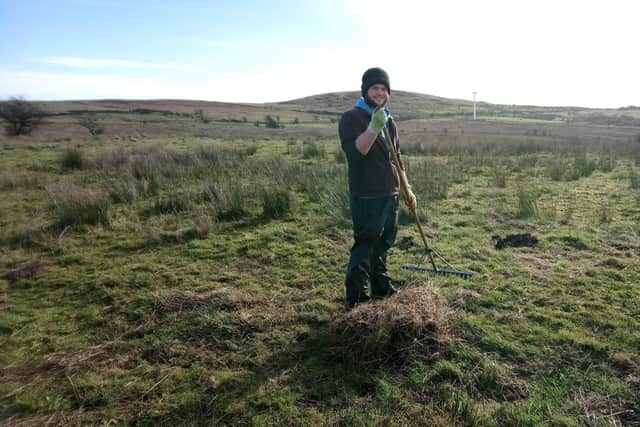It’s high time that farmers got back to the basics


Eighty-hour weeks are common place. And, on many farms, the real time input could be even greater than this.
But where is all of this frenetic activity taking us? There is no doubt that the challenges – and opportunities – impacting on production agriculture are going to increase in equal measure as we look ahead.
Advertisement
Advertisement
Given this state-of-affairs, I think it’s time to ask the fundamental question: how can we plan for a future that allows farmers to make a living while, at the same time, providing them with the opportunity to enjoy all those other aspects to living that the rest of us take for granted.


Many people will immediately point to the use of new technologies in this regard. No doubt there is a role for this approach. And given local farmers’ absolute love for bit of new shiny machinery/tech about the yard, all of this will happen in due course.
But a building that is expected to stand the course of time must be constructed on solid foundations. In other words, fancy tech only delivers if farmers are getting the basics right. And it is in this context that I feel so many farmers across Northern Ireland need to take a step back and look at the fundamentals of their businesses.
Put another way, I would suggest it’s about getting back to basics.
Advertisement
Advertisement
So let’s go back to the 19th and 20th century for a little while and ask a few pertinent questions regarding the use of basic scientific principles that were identified back then, many of which are totally relevant within the framing industry of today.


Soil testing is the most obvious starting point in this trip down memory lane. I remember my grandfather talking to my own father about all of this decades ago. In fact, it was the first time in my life that I had ever heard the term pH. On reflection, I think my grandfather would have used the word sour when talking about soil that was too acidic.
Soil testing and the subsequent laboratory analysis that is undertaken represent basic science. And to paraphrase a certain antiques expert on the television, getting a soil sample taken and the required analysis completed is as ‘cheap as chips.”
But here’s the scary news. Ninety per cent of our grassland soils are too acidic: the pH is too low. As a result, the nutrient uptake of the slurry and chemical fertiliser that we apply to all of this land is drastically reduced. What a waste.
Advertisement
Advertisement
The remedy to this problem is very simple: add lime. This is not rocket science. Farmers have known about all of this for 150 years and more. In essence, lime is the cheapest and best value-for-money fertiliser that almost every grassland farmers can utilise. The reasons why so many farmers seem to have forgotten about this fundamental practice is beyond me.
But if the basics of soil science fail to float your boat, there’s a 21st century perspective on soil fertility that is about to become ‘uber’ important.
Climate Change is the biggest challenge facing the world today. And, in this context, capturing carbon becomes a very important principle.
It has long been recognised that our soils are a living carbon store. Just how big this resource is will be identified within a very short period of time. However, research ongoing at the Devenish research farm in Co Meath is confirming that a soil’s ability to store carbon and organic matter is directly linked to its fertility status.
Advertisement
Advertisement
What’s more, continuous trial work - going back over 50 years - at AFBI Hillsborough confirms that the regular addition of slurry to grassland increases soil carbon levels.
Carbon trading is already a reality on the world’s financial markets. This represents a way by which large business, that use a lot of hydrocarbon based fuels, can offset the CO2 emissions created.
Looking ahead, I firmly predict that local farmers will be allowed to trade the carbon potential of their soils on these markets. And, of course, the higher the fertility levels of the soils submitted for this purpose, the higher will be their intrinsic financial value. When looked at in this context, soil testing and liming all of a sudden become very ‘sexy’ propositions!
For their part, arable farmers are very conscious of soil pH levels and do lime regularly. However, the predicament they find themselves in is the certainty that most, if not of the fungicide and herbicide chemistries that they have become so reliant upon will not be available to them.
Advertisement
Advertisement
The past two decades have seen cereal growers forget about the tried and tested practices associated with well thought out crop rotations, preferring to push for continuous wheat on the sane land.
The end result of this approach has been a plateauing in yields, the emergence of herbicide resistant weeds and growing consumer disquiet regarding the use of chemicals to make such an approach possible in the first place.
In tandem with these developments we have seen the dawning of a new principle within arable farming: Integrated Pest Management.
Such an approach to crop production is based on the implementation of crop rotation practices that will help farmers deal with weed burdens in a more sustained way. Biological crop protectants are being developed, which will mean that the application of synthetic pest control agents will only be allowed on a need to use basis.
Advertisement
Advertisement
New Zealand is already well down this road. And I sense that Northern Ireland will be following suit in the not too distant future.
Drainage is another activity that many farmers seem to have forgotten about. Large swathes of Northern Ireland are now home to rushes where once very productive crops of grass and/or cereals would have once been grown.
I known that many farmers will immediately fire back with comments to the effect that drainage work is very expensive and that margins from farming have been very tight over recent years.
And I would agree totally with such sentiments. Farm Minister Edwin Poots envisages a future for agriculture within which the elements of food production and environmental protection can be mutually achievable objectives.
Advertisement
Advertisement
On that basis, I see no reason why the introduction of bespoke drainage .....and fencing....schemes, which would be used to revitalise our best farming land, cannot be included within his vision for the future.
It’s hard not to overlook the fact that animal production accounts 90% plus of the output generated by production agriculture in Northern Ireland. Dairy is our fastest growing sector, with that industry doubling its output over the past 20 years.
Dairy is also the sector that, arguably, has seen the greatest uptake of new technologies, robotic milking being the most obvious example of this. But even here, there remains numerous examples of farmers not making best use of tried and tested ‘science’ that hs been with us for generations.
Milk recording is a case in point. Last time I checked, the majority of milk producers in Northern Ireland did not use this cow/herd management tool as they plot the future course of their businesses.
Advertisement
Advertisement
Dare I suggest that the practical outworkings of this scenario could have very serious consequences for individual milk producers and, potentially, for the dairy industry as a whole.
Recent weeks have been marked by the publication of numerous reports, all confirming that antibiotic usage levels on livestock farms in the UK and Ireland are falling. This is good news for farmers and consumers in equal measure.
Driving this trend is a growing awareness at farm level that improving the fundamental health standards of herds and flocks will deliver life time improvements in animal performance without the use of antibiotics in the first place.
Veterinary surgeons are also playing their part to this end by encouraging the use of such practices as selective dry cow therapy.
Advertisement
Advertisement
But there is so much more that can be done right now to further reduce the level of antibiotic usage within production agriculture
Of all the sectors within Iocal agriculture, dairy is the one where immediate improvements can be secured. But all of this comes back to the fundamental question: do we know that we have a problem in the first place?
Identifying cases of clinical mastitis is a pretty straightforward matter. Curds will be evident and the affected quarter or quarters will be sore to touch. But what about the more pervasive issue of high cell counts?
This issue, more than any other, impacts on the price a farmer gets for his or her milk. And, yes, the bulk tank figure confirms that there is a problem on the farm: but how to find the problem cows?
Advertisement
Advertisement
Regular milk recording provides significant light on this matter. For their part, dairy farmers with robotic milking systems can take this to the next level as they are getting ‘real time’ information on the conductivity – and by subsequent deduction - the cell count status of the milk produced by each cow in the herd. But the vast majority of dairy farmers still milk their cows courtesy of a traditional start up. And this state-of affairs is unlikely to change in the foreseeable future.
Further, potential, good news comes in the form of research organisations committing to delve more deeply into the impact antibiotic usage is having on our farms. An excellent example of this is the recent announcement by Queen’s University Belfast and the Agri-Food and Biosciences Institute (AFBI) to further explore the links between current mastitis control practises and antimicrobial resistance (AMR).
But all of this will count for nothing if farmers are not in a position to take the real time management decisions that makes it all work. In my opinion, accurate information on a cow’s cell count status has the potential to revolutionise the use of antibiotics within the milk sector.
I would go so far as to claim that it should be made mandatory for every dairy farmer in Northern Ireland to be milk recording. It is worthy of note that the Kerry Group is, to all intents and purposes, going down this route.
Advertisement
Advertisement
Here, a carrot and stick approach is being used. The co-op is providing financial support to allow all its milk suppliers commit to milk recording. For those who do not run with this approach, I sense that Kerry will be very displeased.
I see no reason why every milk buyer in Northern Ireland cannot take the same approach with its farmer-suppliers.
Courtesy of this article, I have touched on a few examples of where I believe farmers in Northern Ireland have overlooked of tried and tested management systems and technologies that are as relevant today as they were back before we became very sophisticated.
Good farming practice is not rocket science. Trying to make it that, gets us away from the basic principles that will always deliver optimal performance in a wholly sustainable manner.